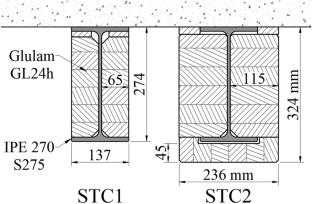The fire resistance and the thermomechanical behaviour of Steel–Timber Composite (STC) beams are studied through 4 fire tests. 35 non-loaded reduced specimens and 2 mechanically loaded real-scale beams were tested considering standard fire conditions (ISO 834 temperature-time curve). The tested configurations consist of various steel profiles associated with timber elements in such a way that steel is fully or partially protected from fire. Timber is used as a fire-protective material since it has a low thermal conductivity and a predictable charring rate. The fire tests on non-loaded reduced specimens allowed us to investigate a wide variety of configurations and to identify key parameters. It is found that full timber protection is very efficient as steel remains below 250°C during 35 or 70 min when timber protection is respectively 30 or 50 mm thick. Moreover, timber moisture is found to have a beneficial impact on steel temperature, while hollow sections favour timber combustion and steel heating during the cooling phase. The full-scale mechanically loaded fire tests highlight the importance of assembly joints because deflection can open them, which accelerates the heating of steel. Finally, an 81 min fire resistance was measured for an STC beam with a 45 mm thick timber protection. These findings contribute to better understand the behaviour of steel–timber structural elements in fire situations. It appears that a judicious mixing of timber and steel can significantly improve the fire performance of these structural elements. The presented results can be used to improve the design of STC beams.




